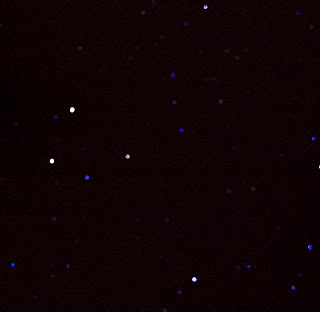June 29th 0945 GMT
It was a bit hazy but I was able to see the sunspot through the “Mak”. I took 14 frames on my compact digital camera.June 29th 2340 GMT
It cleared enough for some constellation shots and I took a dark frame in an effort to improve them. I had to improvise on support for the camera, as my tripod was already packed. It seemed that my lens cleaning hadn’t worked properly. I also experimented with some lunar shots at low ISO, short exposure settings to see what I might get.
An initial view seemed to suggest that my lens cleaning hadn’t worked as well as I’d hoped.
First was Cassiopeia:
Then Cygnus and Lyra, two of my favourites:
A rare one of Sagitta:
... and finally a peek at the zenith.
The Moon picture showed some albedo features but the lunar image was incredibly small to work with.
June 27th 0825 GMT
A later solar bin scan revealed a single sunspot.
June 27th 0735 GMT
I bin scanned the Sun but the haze was too thick to see any sunspots.
June 26th 0930 GMT
I popped out for a quick “white light” solar shoot. Just one large sunspot was readily visible in the hazy conditions. I took a few full disc frames with my Mak and compact digital camera.June 25th 2050 GMT
It was difficult to find in the finderscope and invisible to the unaided eye but I managed to capture Venus by webcam.
June 25th 1000 GMT
A later attempt was more successful but didn't capture the small prominences. I used the DSLR with ISO 200 and 0.02 seconds exposure. The resulting image was composed of Red, inverse Cyan and inverse Black.
June 25th 0910 GMT
I checked the Sun with the PST and there seemed a lot of surface activity, especially surrounding the sunspot but no prominences. I didn't manage to get a photo.
June 25th 0810 GMT
Finally some live action with a white light solar shot. This time I used an inverse magenta channel to produce what I think looks more like a disc.
June 25th
Unable to photograph the Moon due to streaming hay fever, I reprocessed a solar close-up from
September 25th 2011.
September 25th 2011.
June 23rd
Missing any solar action and the supermoon, I reprocessed a solar image from September 25th 2011.
June 21st 2200 GMT
Conditions had become hazy again and the Moon was the only feasible target. Although I took 31 frames, I stacked only two of them. Like with the solar shots, I tried splitting CMYK as well as RGB and mixed the blue with the negative cyan image. Daft? Yes, but it appeared to work.
June 21st 1630 GMT
It had cleared enough to get the PST out for what seemed like yonks (3.14159... years). There was lots of surface details and a few prominences but even adjusting the exposure times and ISO settings on the newer compact digital camera produced results inferior to the old one.
June 21st
Conditions were far from perfect but, by lunchtime, it had cleared enough to see sunspots through thin, moving cloud.
June 20th
I reprocessed two solar hydrogen alpha shots from September 24th 2011 to obtain more surface detail in part of the disc that I had not done previously.
June19th morning
An early morning check showed new sunspot activity.
June 17th 1515 GMT
A solar binocular scan in bad conditions did not reveal any sunspots.
June 17th
I reprocessed some solar images from September 24th 2011.
June 16th
With a complete washout, I reprocessed a Pleiades shot from September 24th 2011.
June 15th
I reprocessed a solar "white light" shot from September 23rd 2011 using GIMP on the stacked image.
June 15th
A solar bin scan through a gap in the clouds at 0815 GMT revealed a disc devoid of sunspots.
June 13th
Finally reunited with my equipment after my business trip to France, I checked the Sun for sunspots with my binoculars.
June 10th
I revisited some old narrow field Pleiades shots from September 18th 2011 and combined the using Registax 5.
June 9th
I thought that it was just England and higher latitudes that sufferred a lack of darkness in late spring and summer but even at 48 degrees 44 minutes north, I had similar problems. It was local midnight (2200 GMT) before it actually got dark. I had a browse around with some 7x30 binoculars, while trying out the DSLR on the local skies.
I managed to see Alcor/Mizar, Delta and Epsilon Lyrae and Beta Cygni quite well but M13 was difficult and looked nothing like as good as what it does in my 15x70 binoculars. Saturn showed the oval-type shape, suggesting rings and the only other object of note was Melotte 111, which showed up quite nicely, looking more compact than it does in my larger binoculars.
The first series of shots I took was the Plough. Then comes Cygnus, Lyra, Melotte 111 and Cassiopeia.
June 7th
With no "live action" for a few days, I reprocessed a lunar photo from September 18th 2011.
June 2nd 0620GMT
I
bin scanned the Sun and found, despite the day before’s clear disc, that there
were two new sunspots that had emerged.








































